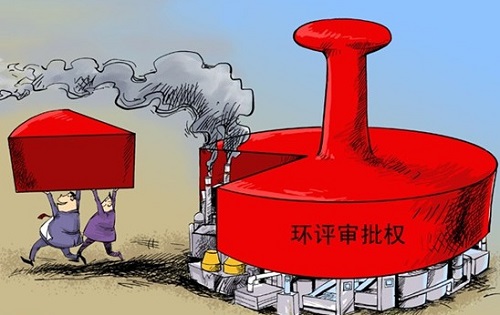A decision by the Ministry of Environmental Protection last march to allow local governments more power in approving new power plant proposals appears to be all but backfiring.
去年3月,環(huán)保部權(quán)力下方,將建設(shè)項(xiàng)目審批權(quán)下放至各地政府,但卻適得其反。
Originally intended to enhance administrative efficiency, the decision has led to the approval of a slew of new power projects in direct contradiction of the government’s environmental agenda.
原想提高行政效率,沒成想?yún)s批復(fù)了大量新建設(shè)項(xiàng)目,顯然與政府的環(huán)保計(jì)劃背道而馳。
In the northern province of Shanxi alone, 23 coal-fired power plants won approval from March to October last year.
從去年3月到10月,僅山西就批復(fù)了23個(gè)新項(xiàng)目。
Two of them, proposed by China Coal Pingshuo Group and China Resources Power Holdings, were previously shot down by the ministry due to concerns about air pollution.
這其中就包括中煤平朔、華潤電力低熱值煤項(xiàng)目,這兩個(gè)項(xiàng)目曾因空氣污染遭環(huán)保部否決。
Three other such projects were also approved in Inner Mongolia.
3個(gè)內(nèi)蒙古項(xiàng)目也通過環(huán)評(píng)。
Coal-rich provinces like Shanxi have actively promoted plants that use waste materials from coal-mining to generate electricity in order to boost economic growth in the past.
以前,煤炭大省山西曾利用煤炭廢料發(fā)電,促進(jìn)經(jīng)濟(jì)增長。
And given that these regions have been on the blunt end of the national economic slowdown, temptations to allow such operations would have been irresistible.
隨著經(jīng)濟(jì)放緩,采用廢料發(fā)電已勢不可擋。

Indeed, it is worth noting that economic growth has been a major determinant of provincial officials’ prospect for promotion.
值得注意的是,地區(qū)經(jīng)濟(jì)增長對地方官員晉升有著決定性作用。
But the key problem here is the usage of waste materials from coalmines, which include gangue, slime and middling.
但主要問題出在了煤礦廢料發(fā)電,煤炭中包含了大量脈石、爛泥以及中礦。
China produces some 300 million tons of them, but only a third of it goes to power facilities.
中國每年會(huì)產(chǎn)生約3億噸煤炭廢料,但只有三分之一用于能源。
The rest are left unused, sprawling over some 13,000 hectares of land. And in their idle state, they not only create harmful gases but also pollute nearby soil and water.
其余擱置不用,約1.3萬公頃土地遭污染。這些廢料不僅會(huì)產(chǎn)生有害氣體,還會(huì)污染附近土壤水源。
However, using them to produce power generates greater amounts of dust and sulphur dioxide emissions than using materials with higher quality.
較使用環(huán)保材料,廢料發(fā)電會(huì)產(chǎn)生更多灰塵,更多二氧化硫。
And central authorities say this is something that the smog-choked skies of Northern China cannot afford to take on.
但據(jù)中央政府表示,北方的污染天氣不適宜采用廢料發(fā)電。
Such dilemma has been at the bottom of a vacillation in policy.
相關(guān)政策也是搖擺不定。
For instance, in 2011, the National Energy Bureau issued a notice saying the country should stop developing the sector that uses coalmining waste.
2011年,國家能源局發(fā)表聲明,稱應(yīng)停止煤炭廢料發(fā)展。
But, in 2013, the Bureau had allowed the Shanxi government to draft plans for the very activity it discouraged.
而在2013年,國家能源局允許山西政府起草廢料發(fā)展方案。
Two years later, by March 2015, the Ministry of Environmental Protection had rejected many of those proposals, just before passing down authority to provincial governments to decide whether to approve such projects.
但到2015年3月,就在環(huán)保部權(quán)力下放之前,多個(gè)項(xiàng)目遭環(huán)保部否決。
譯文屬可可英語原創(chuàng),未經(jīng)允許,不得轉(zhuǎn)載。











